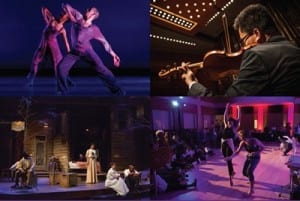The New York Observer newspaper relied on the expertise of Zannie Voss, director of SMU’s National Center for Arts Research (NCAR), for an article about how museums are faring at a time with tighter budgets, less revenue and an evolution in museum-going behavior.
Voss is chair and professor of arts management and arts entrepreneurship in the Meadows School of the Arts and the Cox School of Business at SMU. She has a worked as consultant on projects for the Irvine Foundation, the League of American Orchestras, Theatre Development Fund and Theatre Communications Group, co-authoring TCG’s Theatre Facts since 1998. She has published over a dozen articles in academic and practitioner journals on research examining the strategic factors that influence organizational performance in the arts using multiple stakeholder measures.
The Observer article, “Is Bigger Always More? How U.S. Museums Fared in 2016,” published Dec. 26, 2016.
EXCERPT:
By Daniel Grant
Observer
It was the best of times, it was the worst of times? The Metropolitan Museum of Art set a new attendance record in fiscal year 2016, bringing in 6.7 million visitors, the fifth year in a row that more than six million people have come through the doors in a given year. However, the institution reported a $10 million general operating deficit, requiring it to institute a hiring freeze, lay off dozens of staffers and put on hold an addition to the Lila Acheson Wallace Wing.This might be just an oddity, but other art museums have experienced financial troubles as well. The Museum of Modern Art has offered early retirement buy-outs for its older employees in order to trim its budget, and a $3 million deficit has compelled the Brooklyn Museum to offer its staff early retirement packages. The San Diego Museum of Contemporary Art, which is planning an expansion that will triple its exhibition space, is eliminating eight full-time and 20 part-time employees, and the Cincinnati Museum Center has cut 60 jobs in order to stem the flow of red ink while it prepares its own expansion.
“Museums are in a period of transition, as they are spending more on marketing … and attracting more people through new educational, digital and other programming while garnering less revenue per person who attends,” said Zannie Voss, director of the National Center for Arts Research at Southern Methodist University in Dallas. Spending by the average visitor has declined from $25.81 in 2012 to $17.52 in 2015, according to data from DataArts, one of NCAR’s partners, for more than 100 art museums around the country. Meanwhile, those same institutions have increased their programming by 67 percent, raising their costs while earning less per visitor.
“Museums are striving for larger and more diverse audiences, looking to increase accessibility and remove the economic barriers to visiting, and they are creating new programs to engage people,” Voss said. Program revenues and fundraising have not been keeping up, though, she said, noting that the costs of running the sampled museums have risen 10 percent above inflation and only trustee giving, at nine percent, has kept pace. Growth in the other principal sources of raising funds— through individuals, foundations, corporations and government grants—“have not been as robust and, in the case of individual giving, represent a decrease of seven percent in absolute dollars.”



 NASA data leads to rare discovery: Earth’s moon wandered off axis billions of years ago
NASA data leads to rare discovery: Earth’s moon wandered off axis billions of years ago Good news! You’re likely burning more calories than you thought
Good news! You’re likely burning more calories than you thought New look at Pizarro’s conquest of Inca reveals foot soldiers were awed by empire’s grandeur
New look at Pizarro’s conquest of Inca reveals foot soldiers were awed by empire’s grandeur Charity, social justice and earth-friendly activism replace big houses, diamond rings and ostentatious living for status seekers
Charity, social justice and earth-friendly activism replace big houses, diamond rings and ostentatious living for status seekers National Center for Arts Research white paper counters findings of the Devos Institute Study on Culturally Specific Arts Organizations
National Center for Arts Research white paper counters findings of the Devos Institute Study on Culturally Specific Arts Organizations Long-term daily contact with Spanish missions triggered collapse of Native American populations in New Mexico
Long-term daily contact with Spanish missions triggered collapse of Native American populations in New Mexico North America’s newest pterosaur is a Texan — and flying reptile’s closest cousin is English
North America’s newest pterosaur is a Texan — and flying reptile’s closest cousin is English California 6th grade science books: Climate change a matter of opinion not scientific fact
California 6th grade science books: Climate change a matter of opinion not scientific fact Reading ability soars if young struggling readers get school’s intensive help immediately
Reading ability soars if young struggling readers get school’s intensive help immediately







